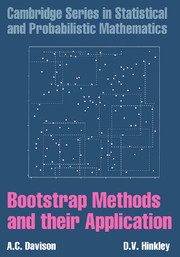Book contents
- Frontmatter
- Contents
- Preface
- 1 Introduction
- 2 The Basic Bootstraps
- 3 Further Ideas
- 4 Tests
- 5 Confidence Intervals
- 6 Linear Regression
- 7 Further Topics in Regression
- 8 Complex Dependence
- 9 Improved Calculation
- 10 Semiparametric Likelihood Inference
- 11 Computer Implementation
- Appendix A Cumulant Calculations
- Bibliography
- Name Index
- Example index
- Subject index
9 - Improved Calculation
Published online by Cambridge University Press: 05 June 2013
- Frontmatter
- Contents
- Preface
- 1 Introduction
- 2 The Basic Bootstraps
- 3 Further Ideas
- 4 Tests
- 5 Confidence Intervals
- 6 Linear Regression
- 7 Further Topics in Regression
- 8 Complex Dependence
- 9 Improved Calculation
- 10 Semiparametric Likelihood Inference
- 11 Computer Implementation
- Appendix A Cumulant Calculations
- Bibliography
- Name Index
- Example index
- Subject index
Summary
Introduction
A few of the statistical questions in earlier chapters have been amenable to analytical calculation. However, most of our problems have been too complicated for exact solutions, and samples have been too small for theoretical large-sample approximations to be trustworthy. In such cases simulation has provided approximate answers through Monte Carlo estimates of bias, variance, quantiles, probabilities, and so forth. Throughout we have supposed that the simulation size is limited only by our impatience for reliable results.
Simulation of independent bootstrap samples and their use as described in previous chapters is usually easily programmed and implemented. If it takes up to a few hours to calculate enough values of the statistic of interest, T, ordinary simulation of this sort will be an efficient use of a researcher's time. But sometimes T is very costly to compute, or sampling is only a single component in a larger procedure — as in a double bootstrap — or the procedure will be repeated many times with different sets of data. Then it may pay to invest in methods of calculation that reduce the number of simulations needed to obtain a given precision, or equivalently increase the accuracy of an estimate based on a given simulation size. This chapter is devoted to such methods.
No lunch is free. The techniques that give the biggest potential variance reductions are usually the hardest to implement. Others yield less spectacular gains, but are more easily implemented.
- Type
- Chapter
- Information
- Bootstrap Methods and their Application , pp. 437 - 498Publisher: Cambridge University PressPrint publication year: 1997

